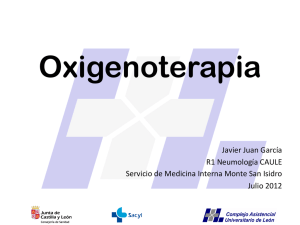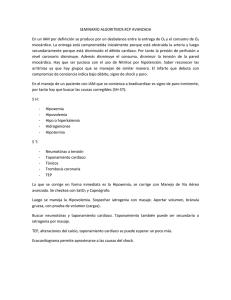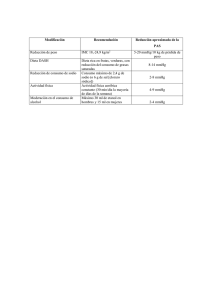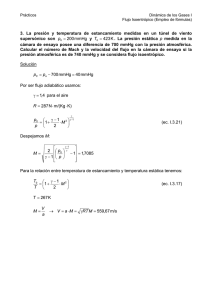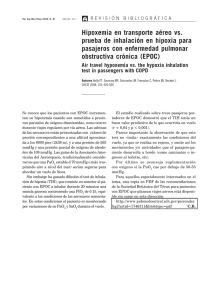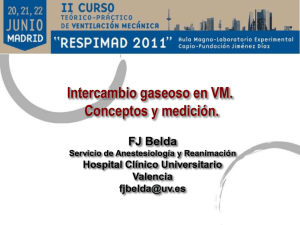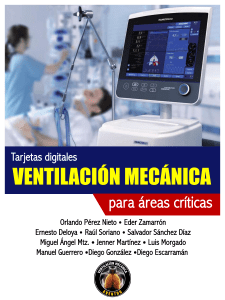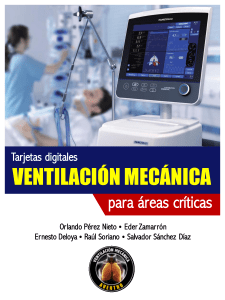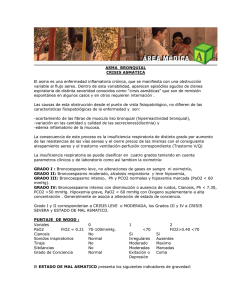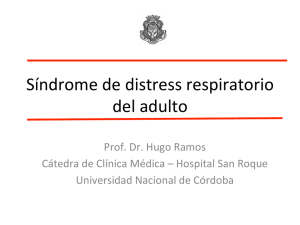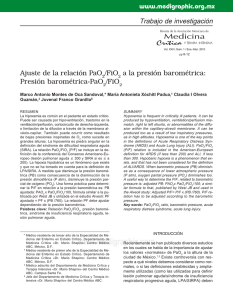Efecte inflamatori de l`oxigen
Anuncio
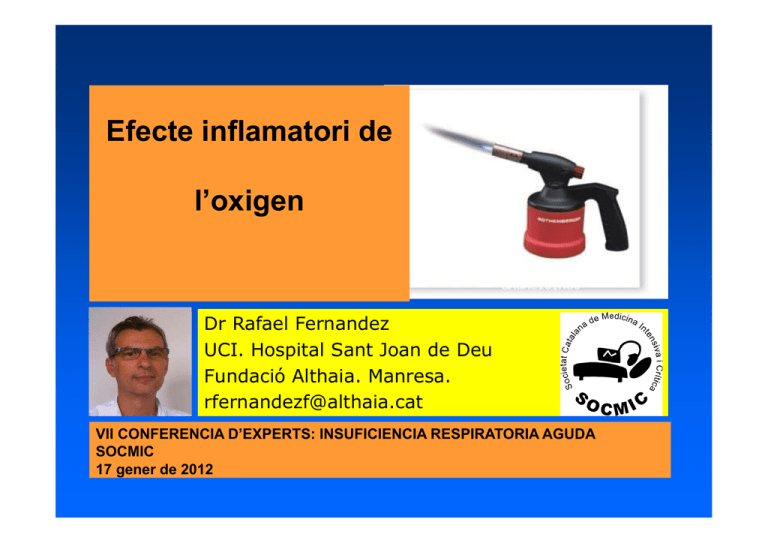
Efecte inflamatori de l’oxigen Dr Rafael Fernandez UCI. Hospital Sant Joan de Deu Fundació Althaia. Manresa. [email protected] VII CONFERENCIA D’EXPERTS: INSUFICIENCIA RESPIRATORIA AGUDA SOCMIC 17 gener de 2012 Hyperoxia and mechanical ventilation High O2 concentrations predispose mouse lungs to the deleterious effects of high stretch ventilation Bailey TC et al. J Appl Physiol 2003; 94: 975–982 Hyperoxia Mediates Acute Lung Injury and Increased Lethality in Murine Legionella Pneumonia: The Role of Apoptosis Tateda K et al. Journal of Immunology, 2003, 170: 4209–4216 Hyperoxia Mediates Acute Lung Injury and Increased Lethality in Murine Legionella Pneumonia: The Role of Apoptosis Tateda K et al. Journal of Immunology, 2003, 170: 4209–4216 Hyperoxia and mechanical ventilation ? Higher versus Lower PEEP in Patients with ARDS The NHLBI ARDS Clinical Trials Network. NEJM 2004; 351: 327-36. El exceso de oxigeno puede confundir nuestros diagnósticos. El caso del SDRA PaO2 75 mmHg PaO2 80 mmHg PaO2 105 mmHg Aboab J et al. Intensive Care Med (2006) 32:1494–1497 Todos sabemos que el exceso de oxigeno es malo, y por eso usamos el mínimo imprescindible A MULTICENTER TRIAL OF PROLONGED PRONE VENTILATION IN ACUTE ARDS Mancebo J et al. AJRRCM 2006; 173: 1233-1239 SI EL OXIGENO ES TAN MALO, ¿POR QUE DAMOS TANTO? AÑADIR OXIGENO EVITA MUERTES SUBITAS EN PACIENTES VENTILADOS Supplemental perioperative O2 and the risk of surgical wound infection: A randomized controlled trial Belda FJ et al. JAMA 2005; 294: 2035-2042 Effect of High Perioperative Oxygen Fraction on Surgical Site Infection and Pulmonary Complications After Abdominal Surgery Meyhof ChS et al. JAMA 2009; 302: 1543-1550 Hypoxemic Resuscitation of Hemorrhagic Shock Douzinas EE et al. J Trauma. 2006;61:918–923 ¿A PARTIR DE CUANTA CONCENTRACION DE O2 NOS HEMOS DE PREOCUPAR? Association between administered O2, PaO2 and mortality in mechanically ventilated ICU patients < 70 70 - 80 80 - 100 De Jonghe E et al. Critical Care 2008, 12:R156 100 - 125 > 125 Supplementary oxygen in healthy subjects and those with COPD increases oxidative stress and airway inflammation HEALTHY COPD 28 % Carpagnano GE et al. Thorax 2004;59:1016–1019 Hipótesis: Dosis bajas de oxígeno pueden producir inflamación pulmonar y aun mayor en pacientes críticos (“second hit”). Objetivo: Evaluar el efecto de reducir la FiO2 (del 0.40 al 0.21) sobre los marcadores de inflamación pulmonar y plasmática en pacientes en VM sin insuficiencia respiratoria. Métodos: Pacientes en VM > 24h sin insuficiencia respiratoria (PaO2/FiO2> 300) y hemodinámicamente estable. Registramos variables en 3 períodos: FiO2 0.4 FiO2 0.21 4h FiO2 0.4 4h Medición de metabolitos de oxidación (NO, NO2, NO3, 8-isoprostano) en plasma y en concentrado del aire exhalado (20’). IL-4, IL-6, IL-10, TNF-a en plasma. FC, TA, SaO2, gasometría arterial y venosa central. Análisis estadístico: Mediana (25%-75% percentiles) ANOVA para medidas repetidas con FiO2 como variable agrupadora, p <0.05 Resultados: Reclutamos 40 pacientes, pero solo 28 de ellos toleraron la reducción de FiO2 al 0.21. Tiempo en VM: 3 (2-6) días Vt: 431(383- 562) ml, FR: 17 (15-19), PEEP: 5 (4-6) FiO2 0.40 FiO2 0.21 FiO2 0.40 79 (71-90) 78 (70-90) 75 (71-87) Systolic blood pressure, mmHg 130 (115-151) 125 (114-138) 134 (120-149) Diastolic blood pressure, mmHg 62 (54-67) 62 (56-67) 65 (56-67) 7.45 (7.42-7.46) 7.45 (7.41-7.48) 7.44 (7.41-7.47) 35 (31-39) 34 (30-38) 36 (32-39) 123 (111-141) 74 (66-78) †§ 134 (110-149) SaO2, % 99 (98-99) 95 (94-97) †§ 99 (98-99) PvO2, mmHg 40 (38-43) 38 (33-42) †§ 42 (38-46) SvO2, % 75 (71-77) 71 (66-75) †§ 76 (71-79) Heart rate, min-1 Arterial pH PaCO2, mmHg PaO2, mmHg 200 TA sistolica (mmHg) 180 160 140 120 100 80 60 1 40% 2 21% 3 40% EBC 20 18 16 14 12 microM 10 8 6 4 NO2+NO3 2 NO3 0 NO2 40% 21% FiO2 40% Plasma 60 50 40 pg/ml 30 20 IL-6 10 IL-10 IL-4 0 TNFa 40% 21% FiO2 40% Conclusión En nuestro medio, el oxígeno rutinariamente administrado (FiO2 0.4) a pacientes críticos ventilados sin insuficiencia respiratoria no hemos podido demostrar que aumente la inflamación ni a nivel local ni sistémico. RESUMEN FINAL EL OXIGENO ES UN MEDICAMENTO QUE DEBE DOSIFICARSE SUS EFECTOS SECUNDARIOS SON CLAROS CUANDO SEA PROFILACTICO, DEBEMOS CONTRAPESAR LOS EFECTOS SECUNDARIOS EXISTEN POCAS INDICACIONES PARA LA HIPEROXIA PODEMOS REDUCIR EL APORTE DE O2 EN MUCHOS PACIENTES CON BUENA MONITORIZACION SIGUE CONTROVERTIDO EL EFECTO INFLAMATORIO A DOSIS BAJAS
